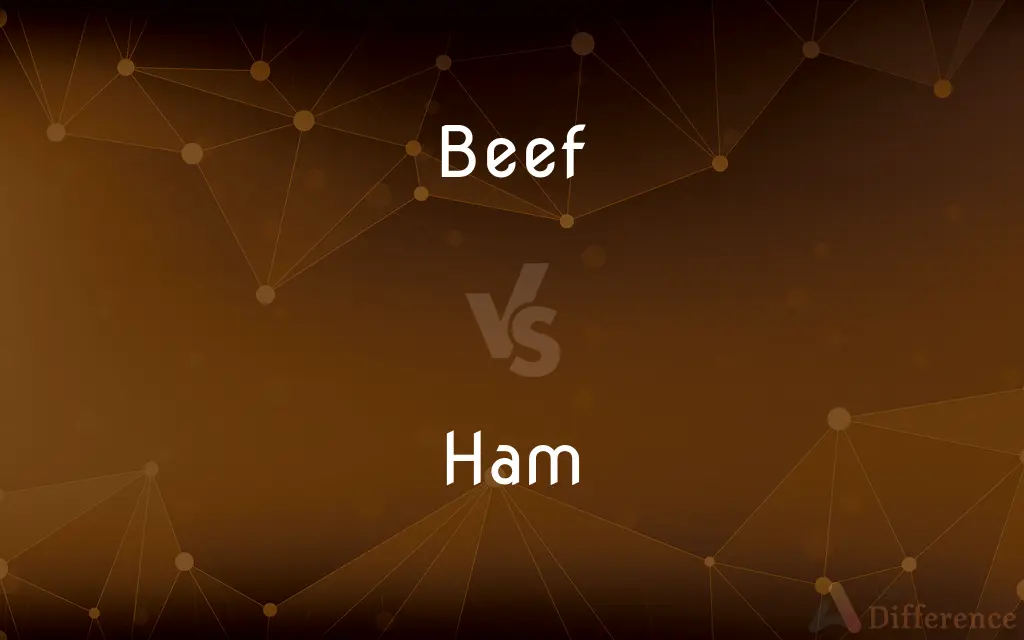Beef vs. Ham — What's the Difference?
By Fiza Rafique & Urooj Arif — Updated on March 5, 2024
Beef comes from cattle and is versatile in dishes, offering rich flavors and varied cuts, while ham, specifically from pigs, is renowned for its curing process and distinct salty-sweet profile.

Difference Between Beef and Ham
Table of Contents
ADVERTISEMENT
Key Differences
Beef, derived from cattle, encompasses a wide range of cuts like steak, ribs, and ground beef, each with unique cooking requirements and flavors. Conversely, ham is a pork product, traditionally cured or smoked, offering a singular taste often associated with holiday feasts and deli meats.
While beef is celebrated for its rich, robust flavor and is a staple protein in many cuisines worldwide, ham is prized for its distinctive salty-sweet taste and convenience, often served sliced in sandwiches or as a centerpiece during special occasions.
Beef's nutritional profile includes high levels of iron, protein, and B vitamins, making it a vital component of a balanced diet for muscle growth and energy. On the other hand, ham, although rich in protein, tends to have higher sodium content due to the curing process, which can be a consideration for those monitoring salt intake.
Cooking methods for beef vary widely, from quick searing for steaks to slow braising for tougher cuts, allowing for a broad culinary range. Ham, however, often comes pre-cooked and cured, requiring less preparation time and is typically reheated or served cold, emphasizing its convenience.
While both beef and ham play significant roles in culinary traditions, their production impacts differ, with beef requiring more resources in terms of land and water, thereby having a higher environmental footprint compared to pork production for ham.
ADVERTISEMENT
Comparison Chart
Source
Cattle
Pigs
Taste Profile
Rich, varies by cut
Salty-sweet, smoked or cured
Common Uses
Steaks, ground beef, roasts
Deli slices, holiday meals, sandwiches
Nutritional Content
High in iron, protein, B vitamins
High in protein, often higher in sodium
Cooking Methods
Searing, braising, roasting, grilling
Reheating, glazing, served cold
Environmental Impact
Higher due to land and water usage
Lower compared to beef, but still significant
Tradition
Versatile in many cuisines
Associated with holidays and deli meats
Preparation
Requires various cooking times based on the cut
Often pre-cooked, focusing on convenience
Compare with Definitions
Beef
Rich in flavor.
Grass-fed beef tends to have a more robust taste.
Ham
Cured pork leg.
We served a honey-glazed ham for Easter.
Beef
High in protein.
Beef is a staple in high-protein diets for muscle building.
Ham
Holiday staple.
Ham is traditionally served during Christmas and Easter celebrations.
Beef
Varied cuts.
The butcher offered a selection of beef cuts, including sirloin and ribeye.
Ham
Often pre-cooked.
Sliced ham is convenient for quick sandwiches.
Beef
Meat from cattle.
The chef prepared a beef bourguignon for dinner.
Ham
Salty-sweet taste.
The ham's salty-sweet flavor pairs well with sweet potatoes.
Beef
Used in diverse cuisines.
Beef tacos are a popular dish in Mexican cuisine.
Ham
High in sodium.
Due to its curing process, ham can be high in sodium.
Beef
Beef is the culinary name for meat from cattle, particularly skeletal muscle. Humans have been eating beef since prehistoric times.
Ham
Ham is pork from a leg cut that has been preserved by wet or dry curing, with or without smoking. As a processed meat, the term "ham" includes both whole cuts of meat and ones that have been mechanically formed.
Beef
The flesh of a cow, bull, or ox, used as food
Beef cattle
There was the smell of roast beef
Ham
(in the Bible) a son of Noah (Gen. 10:1), traditional ancestor of the Hamites.
Beef
Flesh with well-developed muscle
He needs a little more beef on his bones
Ham
Overact
She hammed it up for the cameras
Beef
A complaint or grievance
He has a beef with education: it doesn't teach the basics of investing
Ham
The thigh of the hind leg of certain animals, especially a hog.
Beef
A criminal charge
Getting caught with pot in the sixties was a narco beef
Ham
A cut of meat from the thigh of a hog, often cured by salting or smoking.
Beef
Complain
He was beefing about how the recession was killing the business
Ham
The back of the knee.
Beef
A full-grown steer, bull, ox, or cow, especially one intended for use as meat.
Ham
The back of the thigh.
Beef
The flesh of a slaughtered full-grown steer, bull, ox, or cow.
Ham
Hams The buttocks.
Beef
(Informal) Human muscle; brawn.
Ham
A performer who overacts or exaggerates.
Beef
Pl. beefs Slang A complaint.
Ham
A licensed amateur radio operator.
Beef
To complain.
Ham
To exaggerate or overdo a dramatic role; overact.
Beef
(uncountable) The meat from a cow, bull, or other bovine.
I love eating beef.
Ham
To exaggerate or overdo (a dramatic role, for example).
Beef
The edible portions of a cow (including those which are not meat).
Lean finely textured beef
Boneless lean beef trimmings
Ham
(anatomy) The region back of the knee joint; the popliteal space; the hock.
Beef
Muscle or musculature; size, strength or potency.
Put some beef into it! We've got to get the car over the bump.
We've got to get some beef into the enforcement provisions of that law.
Ham
Obsolete form of home
Beef
Essence, content; the important part of a document or project.
The beef of his paper was a long rant about government.
Ham
The licensed operator of an amateur radio station.
Beef
(uncountable) Bovine animals.
Ham
To act with exaggerated voice and gestures; to overact.
Beef
A bovine (cow or bull) being raised for its meat.
Do you want to raise beeves?
Ham
Meat cut from the thigh of a hog (usually smoked)
Beef
A grudge; dislike (of something or someone); lack of faith or trust (in something or someone); a reason for a dislike or grudge. (often + with)
He's got beef over what you said.
He's got a beef with everyone in the room.
Remember what happened last fall? That's his beef with me.
Ham
(Old Testament) son of Noah
Beef
(Dorset) Fibrous calcite or limestone, especially when occurring in a jagged layer between shales in Dorset.
Ham
A licensed amateur radio operator
Beef
To complain.
Ham
An unskilled actor who overacts
Beef
To add weight or strength to.
Ham
Exaggerate one's acting
Beef
To fart; break wind.
Ugh, who just beefed in here?
Beef
To feud or hold a grudge against.
Those two are beefing right now
– best you stay out of it for now.
Beef
To cry.
David was beefing last night after Ruth told him off.
Beef
To fail or mess up.
I beefed my presentation hard yesterday.
Beef
Being a bovine animal that is being raised for its meat.
We bought three beef calves this morning.
Beef
Producing or known for raising lots of beef.
Beef farms
Beef country
Beef
Consisting of or containing beef as an ingredient.
Beef stew
Beef
(slang) beefy; powerful; robust.
Wow, your audio setup is beef!
Beef
An animal of the genus Bos, especially the common species, Bos taurus, including the bull, cow, and ox, in their full grown state; esp., an ox or cow fattened for food.
A herd of beeves, fair oxen and fair kine.
Beef
The flesh of an ox, or cow, or of any adult bovine animal, when slaughtered for food.
Beef
Applied colloquially to human flesh.
Beef
Of, pertaining to, or resembling, beef.
Beef
Cattle that are reared for their meat
Beef
Meat from an adult domestic bovine
Beef
Informal terms for objecting;
I have a gripe about the service here
Beef
Complain;
What was he hollering about?
Common Curiosities
What defines ham?
Ham is a pork product made from the leg of a pig, typically cured or smoked, known for its salty-sweet flavor.
How does beef nutrition compare to ham?
Beef is rich in iron, protein, and B vitamins, while ham is also high in protein but can have a higher sodium content.
Can beef and ham be prepared in the same way?
Beef requires various cooking methods based on the cut, while ham is often pre-cooked, requiring less preparation.
What are common uses for beef and ham?
Beef is versatile, used in dishes like steaks and roasts, whereas ham is popular in sandwiches and as a festive meal centerpiece.
What is beef?
Beef is meat obtained from cattle, available in various cuts with diverse cooking applications.
Why is ham often associated with holidays?
Ham's convenience and rich flavor make it a favored choice for festive meals like Christmas and Easter.
How do cooking requirements differ for beef and ham?
Beef's cooking requirements vary widely by cut, from quick searing to slow braising, whereas ham usually needs only reheating or is served cold.
What is the best way to cook beef for tenderness?
Slow cooking methods like braising are best for tenderizing tougher beef cuts.
What are the environmental impacts of producing beef vs. ham?
Beef production has a higher environmental footprint, needing more land and water, compared to ham.
Is there a taste difference between beef and ham?
Yes, beef has a rich, variable taste depending on the cut, while ham offers a distinctive salty-sweet flavor.
Which is healthier, beef or ham?
Both have nutritional benefits, but choices depend on individual dietary needs, considering beef's iron content and ham's sodium levels.
Is it possible to find low-sodium ham?
Yes, some brands offer low-sodium ham options for those watching their salt intake.
Can ham be eaten without cooking?
Yes, most hams are pre-cooked and can be eaten cold or reheated.
Why is ham cured?
Curing ham enhances flavor, preserves the meat, and extends its shelf life.
How can beef and ham fit into a balanced diet?
Both can be part of a balanced diet when consumed in moderation, with attention to portion sizes and preparation methods to control sodium and fat intake.
Share Your Discovery

Previous Comparison
Moonset vs. Sunset
Next Comparison
Wead vs. WeedAuthor Spotlight
Written by
Fiza RafiqueFiza Rafique is a skilled content writer at AskDifference.com, where she meticulously refines and enhances written pieces. Drawing from her vast editorial expertise, Fiza ensures clarity, accuracy, and precision in every article. Passionate about language, she continually seeks to elevate the quality of content for readers worldwide.
Co-written by
Urooj ArifUrooj is a skilled content writer at Ask Difference, known for her exceptional ability to simplify complex topics into engaging and informative content. With a passion for research and a flair for clear, concise writing, she consistently delivers articles that resonate with our diverse audience.














































